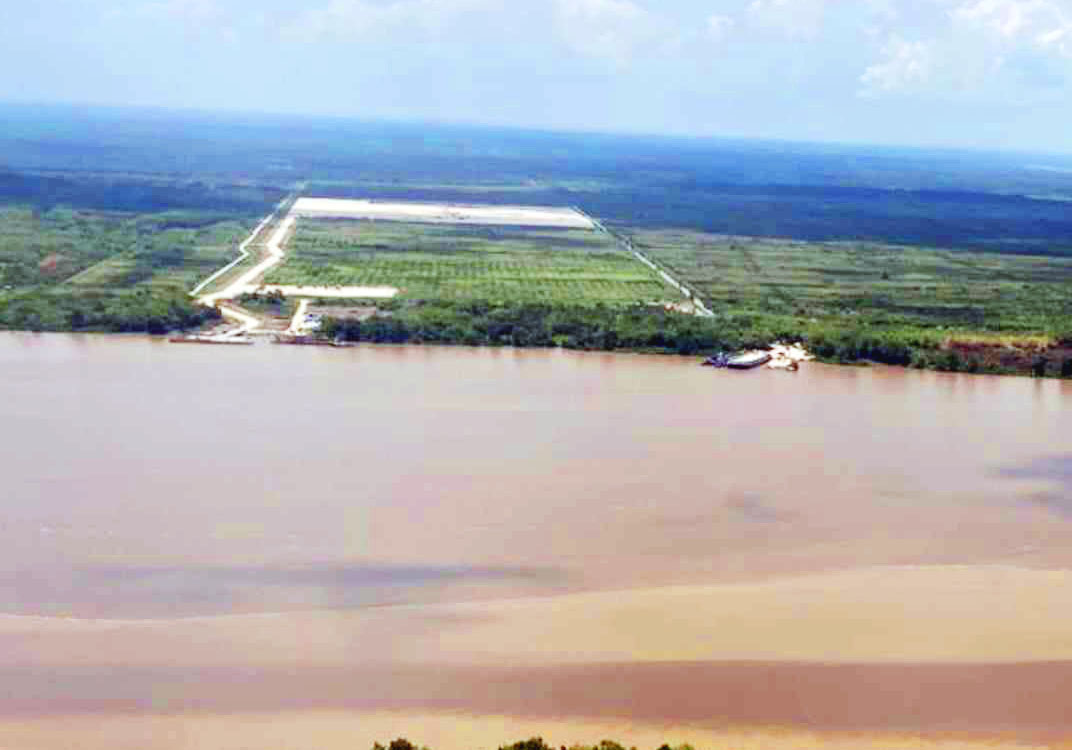President Irfaan Ali yesterday visited the site of the Gas to Energy project at Wales on the West Bank of Demerara and as sand was being stockpiled to consolidate the ground for pile driving, he was told that the first phase of the project should be completed by mid next year.
“We are already engaging in stockpiling … sand,” one of the project Managers told Ali yesterday as he pointed to areas that were being filled.
“This area here, the soil needs to be further consolidated so that the construction can be robustly built on top of it. It would require stacking sand, a couple of meters…not in all the areas but most of them… and then piles will be driven,” he added.
The project phase manager explained that every day some 500 cubic tonnes of sand is brought to the facility by barge and it is then taken to the worksite by trucks where it is used to consolidate the ground to then build the foundation.
He said that after that aspect of the project is completed “Depends on how the soil react they have a good approximation but it is actually contingent on the actual conditions of the soil below. This first phase will be the first half of the year then they’re further stages…the piling, then the building themselves…,” he explained.
The project currently employs about 500 persons and Ali urged contractors to maximize working during the current dry season. “You have to push a little more during this dry season because the weather is cooperating fully now,” Ali said.
The Gas-to-Energy project will establish infrastructure so that natural gas can be transported from the Stabroek Block’s Liza oilfield to an integrated gas processing facility at Wales, West Bank Demerara. The project will deliver natural gas liquids (NGL) and dry gas to the Government of Guyana.
A subsea pipeline is expected to be installed on the seafloor to transport natural gas from the Liza field to an onshore pipeline on the West Coast of the Demerara River.
Onshore, a pipeline will deliver the gas to an integrated facility in Wales. At this facility, a NGL processing plant will treat the gas to extract NGLs for commercial use, and a 300-megawatt (MW) power plant will use the dry gas to generate electricity for domestic use. It is expected that the cost of electricity for consumers will be reduced by some 50 per cent. Currently, the power utility, Guyana Power and Light (GPL), provides electricity at a rate of 15 US cents per kilowatt hour.
This is a joint project between the Government of Guyana and ExxonMobil at a projected cost of US$1.7 billion.
When completed, Guyana will have a natural gas-fired power plant and natural gas to liquids plant, capable of producing at least 4,000 barrels per day, including the fractionation (or separating out) of liquefied petroleum gas (LPG).
ExxonMobil is expected to deliver the completed pipeline to the power plant by the fourth quarter of 2024 to achieve commissioning and testing of the power plant by the end of 2024. Guyana is expected to save some US$500 million annually after paying ExxonMobil US$55 million each year for the 12-inch pipeline.
This US$55 million payment will come from cost oil and would be a “fixed price” for the next 20 years.
The NGL plant will be owned by the Government of Guyana and prior to the conclusion of the construction, an international firm will be competitively selected to operate the project to international standards and best practices.
With development well underway, the mapping of other power lines has been included, as well as the Provision of an Engineering, Procurement and Construction (EPC) Services contract, which will see the installation of transmission lines and substations for the integrated NGL Plant for the 300 MW Power Plant.
Kalpataru Projects International Limited (KPIL) of India was awarded the contract for this project which is expected to be completed next year and is expected to cost some US$159 million.
An aerial shot of the area for the gas to energy project






